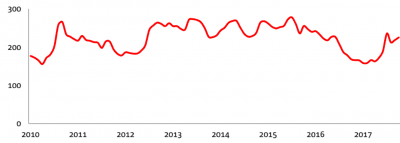AUSTRALIA’s 2017 wheat crop is forecast to be 18.7 million tonnes (Mt), down almost 47 per cent (pc) on the 2016 record crop, according to the October 2017 National Australia Bank rural commodities update released today.
The reports notes the season has been all over the shop.
NAB agribusiness economist Phin Ziebell said weather had been a major driver of local prices and production levels, and that was likely to continue.
“To put it bluntly, the weather has been wildly varied this year,” Mr Ziebell said.
“One of the biggest drops in wheat production will come from New South Wales, which has suffered from very low rainfall, frosts and heatwaves in the space of a single season.
“Meanwhile Western Australia and, more recently, south-east Queensland, have seen soaking rains.

Figure 1: NAB weighted feedgrain price index, A$/t, data from Bloomberg, Profarmer and NAB Group Economics. (Source: NAB)
Feed grain prices (Figure 1) rose 4.4 per cent to $228/tonne in September, as a sharply lower grain harvest became more of a reality.
With most old season now gone, demand for stock feed has been elevated. Hay supply remains perhaps higher, but mostly in southern regions and transport costs will add a premium further north.
Above export parity
While we expect little upturn in grain global prices over the coming months a possible shortage of domestic grain over the next few months will likely keep prices above world benchmarks.
As we move into December and the new year, it is likely that prices will adjust back closer to global levels.
Global grain prices remain very subdued, and with global growing conditions broadly very favourable.
While concerns have been raised about inventory levels outside of China, it would still take a reasonable hit to global production to cause a sustained upward movement in prices. We do not see these conditions being met at present.
Domestic grain is trading at a large premium amid a lack of supply, although this is likely to abate for export grain, which will need to meet the world market.
Weather/dollar outlook
The weather outlook for the remainder of the year and into next is somewhat more positive, with the Bureau of Meteorology forecasting average to above average rainfall for most of the country for the rest of the year.
NAB is predicting downward pressure on the Australian dollar, falling to US75 cents at the end of this year and spending most of next year at the US73c mark.
For interest rates, NAB believes the easing cycle has come to an end, but no move upward until 25bp increases in August and November 2018.
Source: NAB


HAVE YOUR SAY